|
Unit 6: Background to the Mysteries Eleusinian Mysteries Apollo at Delphi Tour of Delphi Timeline of Delphi Festival Calendar |
| Return to Front Page |
| Eleusinian Mysteries |
 |
|
Click on the map for photos and descriptions. You can also pick from the list below, or just scroll through the page and follow the procession in order: Beginnings at Athens Purification and Sacrifice Back in Athens Procession to Eleusis Rites at Eleusis Return to Athens |
| Athens: |
The Greater Eleusinian Mysteries were a set of rites, surrounded by a major multi-day festival, which show numerous ties to the tale of Demeter and Persephone told in the Homeric Hymn to Demeter. (ALL LINE REFERENCES GIVEN BELOW ARE TO THE HOMERIC HYMN TO DEMETER.) The Mysteries were held once each year over nine days (line 47) in the early fall, partly in the city of Athens and partly in the nearby town of Eleusis. 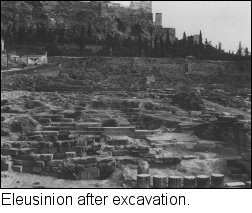 Initiates came from all over the Greek and later the Roman world. Messengers from Eleusis proclaimed a holy truce in Greek city-states lasting fifty-five days. Initiates came from all over the Greek and later the Roman world. Messengers from Eleusis proclaimed a holy truce in Greek city-states lasting fifty-five days.The activities began on the day before the first official day of the Mysteries, when a procession carried the so-called "Hiera," mysterious "holy things" whose nature is unknown, from Eleusis to Athens after preliminary sacrifices. The procession would stop to rest at the Sacred Fig Tree, where according to later legend Demeter stopped to rest and was cared for by Phylatos. As a reward, she gave him the fig tree. The procession then went into Athens to the city Eleusinion, the temple of Demeter in Athens, near the Acropolis. On the first official day of the Mysteries, the Archon Basileus summoned the people to the Agora (marketplace) of Athens and, in the presence of the Hierophant and the Dadouchos, read a proclamation calling forth the initiates. (For explanations of all these officials and their roles, see Background to the Mysteries.) Those who were forbidden from participating included those who had committed homicide, barbarians (after the Persian Wars), and those who could not understand Greek. Those admitted could enter the Eleusinion after washing their hands in lustral water at the door. |
| Back to top |
| Purification and Sacrifice: |
On the second day the participants walked to the sea near Athens and cleansed themselves and a small pig. Upon returning to the city, participants sacrificed the pig.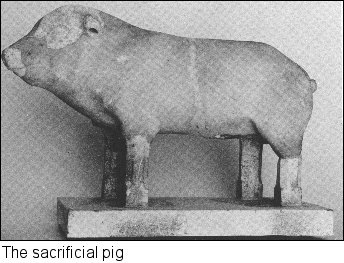
|
|
The activities of the third day, the Day of Sacrifices, are not certain, but it is likely that on this day the Archon Basileus made sacrifices on behalf of Athens, and then theories (delegations) sent to Athens for the occasion made sacrifices on behalf of their home cities. (line 368-8) The fourth day was called Asklepia to commemorate the late purification of the god Asklepios. Tradition states that the god arrived at Athens a day late for his purification. However, the purification rites were repeated so that he could be properly initiated into the Mysteries. On this day, those participants who arrived late are purified. Those who had already been purified stayed home that day and probably received further instructions. |
| Back to top |
| The Procession: |
The fifth day was known as Pompe, or "procession." Officials, initiates, and sponsors proceeded to Eleusis from Athens on foot, a distance of 14 miles, though in the fourth century B.C.E. the rich customarily rode in carriages. 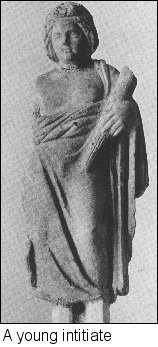 Priests and the Hiera also began riding in carriages at about this time. At the head of the procession was a statue of Iacchos, the personification of the excitement and noise of the procession. Priests and the Hiera also began riding in carriages at about this time. At the head of the procession was a statue of Iacchos, the personification of the excitement and noise of the procession.Ribbons : After the initiates had crossed the bridge of the river Rheitoi, an event known as the "krokosis" took place, named for the legendary Krokos, the first inhabitant of the region. Here, his descendants would tie a woolen "kroke," a saffron-colored ribbon, around the right hand and the left leg of each initiate. Though the purpose of this is not clear, it definitely gave the initiates a chance to rest until sunset, when the procession continued. Insults and jeers : Once the procession reached the river Kephisos, men with covered heads, known as "gephyrismoi," waited to hurl insults, jeers, mockery, and abuse at initiates -- among whom were included important citizens of Athens! The purpose of this action is opaque, but perhaps it was to humble these citizens, or vet them so that evil spirits could not affect them. In any case this aspect of the ritual echoes a vulgarized evolution of the soothing jokes of Iambe (lines 194-205). Finally, upon the arrival of the procession, many dances and festivities were held for the excited initiates before the people dispersed to rest for the night. |
| Back to top |
| At Eleusis: |
At this point, the details of the Mysteries become much less clear due to their secretive nature. The sixth day, called the Telete, or "rites," was probably a day of fasting and purification. 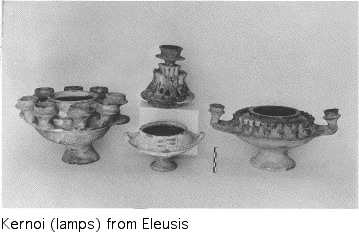 The fasting was probably broken by the drinking of the kykeon, a potion commemorating Demeter's refusal to drink red wine. (lines 208-9) Further sacrifices were made by the Archon Basileus before the final initiation began. (lines 368-9) We know little of this part of the Mysteries, as the ancient sources tell us only that it consisted of "things enacted," probably a sacred pageant telling the tale of Demeter and Persephone, "things said," probably a series of brief liturgical or invocational statements, and "things shown," probably the Hiera and other objects, though again, we cannot be certain. The fasting was probably broken by the drinking of the kykeon, a potion commemorating Demeter's refusal to drink red wine. (lines 208-9) Further sacrifices were made by the Archon Basileus before the final initiation began. (lines 368-9) We know little of this part of the Mysteries, as the ancient sources tell us only that it consisted of "things enacted," probably a sacred pageant telling the tale of Demeter and Persephone, "things said," probably a series of brief liturgical or invocational statements, and "things shown," probably the Hiera and other objects, though again, we cannot be certain.The seventh day was probably spent resting in preparation for the initiate's final night in the Telesterion. The eighth day was mostly for libations to the dead, though there were probably many festivities that day, as well. |
| Back to top |
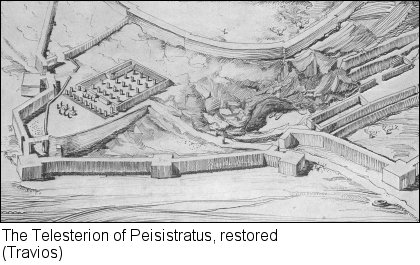 |
| Return to Athens: |
|
The ninth day was the return to Athens and the close of the festival. On the day following, the Archon Basileus and his assistants reported to the Athenian ruling assembly at the Eleusinion on the proceedings and recommended legal action against anyone who had acted impiously. At this point, initiates had no further obligation to the cult and could resume living their lives as they pleased. The Eleusinian Mysteries lasted for well over a millennium and had countless initiates. The Mysteries probably ceased to be celebrated in 396 A.D. with the destruction of the sanctuary at Eleusis and the Eleusinion at Athens by Alaric and the Visigoths. |
| Back to top |
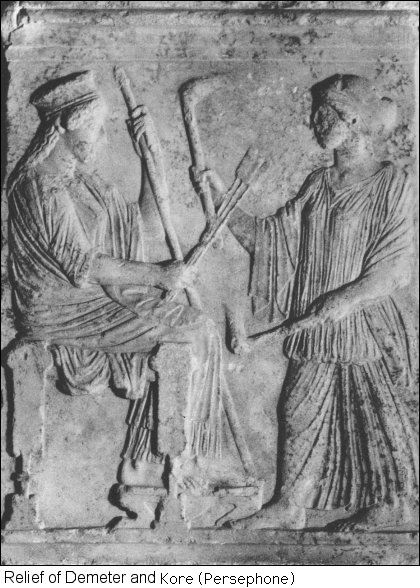 |
| Sources: Miles, Margaret M. The Athenian Agora. American School of Classical Studies Publications, 1998. Mylonas, George E. Eleusis and the Eleusinian Mysteries. Princeton University Press, 1961. |
| Relevant genealogical information: |
|
|
| Timeline of Relevant Events |
|
|
|
Copyright 2000-2020 Peter T. Struck. No portion of this site may be copied or reproduced, electronically or otherwise, without the expressed, written consent of the author. |